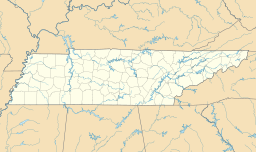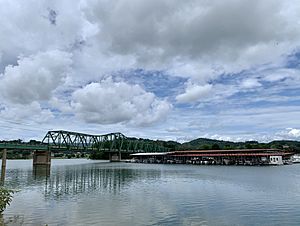Cherokee Lake facts for kids
Quick facts for kids Cherokee Lake |
|
|---|---|
| Cherokee Reservoir | |

Cherokee Lake near Bean Station
|
|
| Location | Grainger / Hamblen / Jefferson / Hawkins counties, Tennessee, United States |
| Coordinates | 36°12′54″N 83°26′06″W / 36.2149°N 83.4350°W |
| Type | Reservoir |
| Primary inflows | Holston River |
| Primary outflows | Holston River |
| Basin countries | United States |
| Managing agency | Tennessee Valley Authority |
| Surface area | 28,780 acres (11,650 ha) |
| Average depth | 30 ft (9.1 m) |
| Water volume | 749,400 acre⋅ft (924,400,000 m3) |
| Shore length1 | 400 mi (640 km) |
| Settlements | Bean Station, Morristown, Jefferson City |
| 1 Shore length is not a well-defined measure. | |
Cherokee Lake, also known as Cherokee Reservoir, is a large human-made lake in Tennessee, United States. It was created by building a dam across the Holston River. This lake is an important part of the area, providing electricity and helping to control floods.
Contents
About Cherokee Lake
Cherokee Lake covers about 28,780 acres (11,650 ha) of water. It has nearly 400 miles (640 km) of shoreline, which is a very long distance! The lake can hold a lot of water, about 749,406 acre-feet (924,379,000 m3). In a typical year, the water level in the lake changes by about 27 feet (8.2 m). This change helps manage water flow and prevent floods.
Fish and Wildlife
Cherokee Lake is home to many different kinds of fish. You can find Black bass, sauger, walleye, crappie, and various types of sunfish here. These fish make the lake a popular spot for fishing.
Building the Lake
The story of Cherokee Lake began in 1940. The Tennessee Valley Authority (TVA) started buying land in places like Jefferson City and Bean Station. They planned to build Cherokee Dam and create the lake.
Many families had to move from their homes and farms. It was a big change, but the TVA promised flood control and electricity for the area. For the town of Bean Station, the lake plans meant that the original town site would be underwater. About 140 families had to leave their homes there.
Officials from the TVA and the community talked about how to move the town. They even planned new places for Bean Station residents to live. However, some landowners didn't want to sell, and people didn't want to move as a whole community. So, the idea of moving the entire town together was stopped. People ended up moving on their own.
The Dam's Construction
The Cherokee Dam was built very quickly. Construction started on August 1, 1940, and was finished on December 5, 1941. This dam is run by the TVA. It helps create electricity and stops floods.
The dam and the lake were named after the Cherokee Native American tribe. This area was once where the tribe lived before the river was dammed. A famous path called the Great Indian Warpath, used by pioneer Daniel Boone, is now under the lake's waters.
Fun at Cherokee Lake
Today, Cherokee Lake is a very popular place for people to visit and have fun. There are many things to do, like:
- Boating
- Swimming
- Canoeing, kayaking, and paddleboarding
- Camping
- Water sports
- Fishing
You can find public boating areas, Panther Creek State Park, and other parks around the lake. There are also places to stay, like lakefront resorts and campgrounds for RVs and tents. A state wildlife management area is also located on the lake's shores.
Fishing Fun
Cherokee Lake is known for having lots of fish. This makes it one of the best places for fishing in East Tennessee. In 2019, a magazine called Bassmaster even ranked Cherokee Lake as one of the top 25 bass fishing lakes in the Southern United States. In October 2020, the lake hosted a big fishing tournament called the 2020 Bassmaster Eastern Open.




